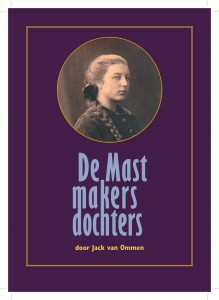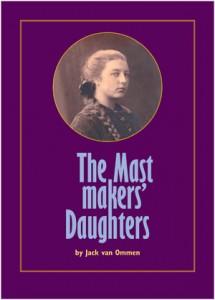the cover of “De Mastmakersdochters”.
My earlier ideas to try and tell the story with a number of photographs, just did not work. The synopsis of the story is on the back cover and I hope that the cover offers enough intrigue to flip the book.
Tekst op achterkant omslag:
Rennie de Vries schrijft met veel gevoel en vaak heel persoonlijk over haar herinneringen vanaf 1901 in de Lemmer, waar zij opgroeide boven de mastmakerij. Haar nicht, ook een Rennie de Vries, groeit op in Duitsland waar haar vader een mastmaker is. In de oorlog is de nicht lid van de NAZI partij en Rennie werkt in het verzet. Rennie wordt, als jonge moeder, gearresteerd en het verhaal volgt haar en haar lotgenoten via Vught, Ravensbrück naar Dachau en de jaren na de oorlog van Rennie en haar nicht. De schrijver heeft een, tot nog toe onbekend, bijzonder stuk oorlogsgeschiedenis van het “AGFA Commando” samengesteld. Twee honderd moedige vrouwen die samen zingen, bidden, huilen en lachen. Van Ommen ontdekte, vaak schokkende, feiten en misconcepties over de oorlogsjaren. Dit is een verhaal over een Zuiderzeehavenstad tot de drooglegging, van zeilvaart naar stoom en dieselmotoren, over Urk, Groningen, de veenkolonies en de eerste wereldoorlog. Rennie nam geen genoegen met de ongelijkwaardige rechten van vrouwen in het begin van de 20e eeuw.
Zij was één van de eerste bestuursleden van de Gereformeerde Meisjes Vereniging. Haar medegevangenen kozen Rennie als hun Blockälteste. Boven alles is dit boek haar getuigenis van haar rotsvast geloof een kind van God te zijn.
Translation:
Rennie van Ommen-de Vries writes a detailed memoir, starting in 1901, of growing up in de Lemmer above the mastmaker shop. Her cousin, by the same name Rennie de Vries, grows up in Germany where her father is mastmaker. The German cousin becomes NAZI party member and Rennie van Ommen joins the Dutch resistance. She is arrested and the story follows her through the prisons and concentration camps of Vught, Ravensbrueck and Dachau and the post war experiences of her and her German cousin. The writer has managed to reconstruct a complete story, which until now were fragmentary unpublished reports. In particular about the 200 women of the so called “AGFA-Kommando”, how these brave women survived and how they sang, prayed, laughed and cried together. Van Ommen discovered, often shocking, facts and misconceptions about the war years. This is a story about a port city on the Zuiderzee till the sea was tamed to a fresh water lake, of the change from sail to steam and later diesel propulsion. Over the Mastmaker daughter’s life experiences in places like the island of Urk and the affects of the 1st World War. Rennie embraced the emancipation and became active in the first Christian women movement. Her co-prisoners elected her to be Blockaelteste, as their spokesperson with the concentration camp guards. Above all this is the profession of Rennie’s faith in the Lord through her life but in particular for her and her companions during her imprisonment.
The cover is the very last step in bringing the book out. I should have more details for you in the next days. Today is All Saints. For me a very appropriate day to bring this tribute out to a very special woman. My next focus is on getting the English version into publication.
Yesterday was a gorgeous sunny cold day and I had a chance to remove the sails and some of the settee cushions from the boat and store them in the dry boat shed. I also winterized the engine. Today was another nasty windy wet day. I rode my folding bike to the office of the cover designer, Victor Levie, in the Lutmastraat. Which is near where I grew up. I came through the Nierstraat, where the Anne Frank school is. The entire exterior of the school is tiled with text of the handwritten diary. One of the discoveries I made, in the research for the above book, is that the very same two SD officers who were in charge of arresting the Frank family in August 1944 also arrested my father four months earlier. The Franks followed the same route as the Mastmaker’s Daughter to the Weteringschans prison in Amsterdam. I might have mentioned this before. my father received one of the very first issues of the Diary of Anne Frank from her father, Otto, with his dedication in it.







